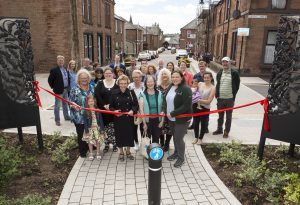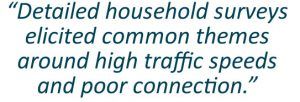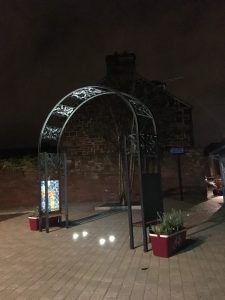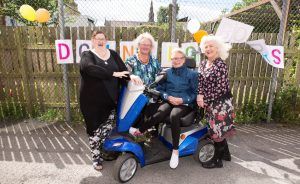As the First Minister’s poverty adviser Naomi Eisenstadt noted in a recent lecture, when you ask people in any community what bothers them the most about where they live, the physical environment is most likely to be brought up first. Litter, traffic problems and graffiti are often cited as priority issues. In this article, Paul Ruffles and Emily Davie of Sustrans Scotland, a charity that promotes walking and cycling, tell us about how they helped a Dumfries community to address some of these issues through an urban design initiative.
Sustrans Scotland, in partnership with Dumfries and Galloway Council and local residents and business owners, has supported a transformation of a once neglected and problematic district in Dumfries into a people centred distinctive neighbourhood.

A celebratory event marked the project’s conclusion
The project complements regeneration work by the Strategic Housing Department at Dumfries and Galloway Council and is centred on an area of Victorian sandstone housing and businesses near the centre of Dumfries.
Detailed household surveys elicited common themes around high traffic speeds and rat running and feelings of little sociability and poor connection to others in the neighbourhood.
Process
The goals of the project were to:
- Make the streets more effective in supporting active and sustainable travel.
- Inspire and support the community’s interest in their immediate surroundings through the redesign of their neighbourhood.
- Redesign streets and neighbourhoods to improve relationships between different users, make them safer, more attractive and more sociable.
 The neighbourhood is effectively a residential ‘island’ isolated from surrounding streets by two busy roads. With the luxury of a flexible scope, the project was expanded from a single street to the neighbourhood scale. This had positive benefits in increasing the participation levels and also maximising the place making and active travel potential of the area.
The neighbourhood is effectively a residential ‘island’ isolated from surrounding streets by two busy roads. With the luxury of a flexible scope, the project was expanded from a single street to the neighbourhood scale. This had positive benefits in increasing the participation levels and also maximising the place making and active travel potential of the area.
The project began in May 2013 with the appointment of an embedded officer and the first public event. Regular events were held to progress design proposals and support other local led improvement initiatives. Event attendance has been around 11% of the population in the neighbourhood with c. 600 attendee visits over the project timeframe.
Achievements
- New people friendly street layouts co-designed directly with residents and stakeholders;
- 20mph designation and fully accessible neighbourhood;
- New directional signage for walking and cycling;
- Installation of on street planters and trees;
- Iconic gateway artwork and mural co-designed with artists and residents;
- New lighting columns, litter bins, street signage, noticeboard designs chosen by residents.

The project created new street infrastructure including this Archway in Brooms Road
The DG1 Neighbours Group have also taken on:
- Set up of the DG1 Neighbours Facebook page;
- Planting and adoption of a new civic space and community planter;
- Organisation of events – litter picks, planting days, Big Lunch event and yarn bombing;
- Adoption of the on-street planters and planting in the new civic spaces.
Uniquely we’ve been working with two departments, Strategic Housing and Infrastructure and Transportation Services, at Dumfries and Galloway Council as project partners. This has enabled the project to have a broader place making focus than perhaps other active travel projects would have had.
Reflections
With a broad project reach we’ve been able to identify and use local assets to make the project more context reflective and sustainable. The Victorian aesthetic has been a strong theme in the area, although not necessarily supported by everyone. This theme has been used to inform collective design decisions through the selection of materials, colour, street furniture and signage giving the outcomes local resonance. Through events and direct engagement local creative talents and businesses have been purposely brought into the project, tying interests to the project and long term outcomes.

Residents created a Neighbours Facebook page to build on the project’s legacy
The initial programme of 24 months was increased to accommodate an extended design process. Whilst this presented concerns over engagement and motivation levels it provided a chance to be more flexible and look at improving the broader ‘social health’. Time was spent supporting residents to setup activities around their interests like front garden competitions, planting sessions and art workshops. These events brought people together, strengthened social connections and also helped to embed that wider sense of ownership and care of the neighbourhood.
Critical to the project has been the enthusiasm of a core group of residents who have stood up and helped shoulder the project during tougher periods. The core residents have been able to galvanise and show support during the tougher times like changes in the parking arrangements and objections to the on street planters, but have also acted as ‘critical friends’ providing a sense of perspective during the difficult days.

Despite the long journey and many late nights fretting over the fine details, politics and aspects of the project have ultimately ended in a positive and well-considered enterprise for us all. We’ve travelled from consultation and engagement through a genuine journey of co-design, collaboration and empowerment.
The slower, well-designed, people-friendly and distinctive neighbourhood has clearly helped to transform what was a troubled area into a place where people are investing and actively caring for what would have been in the Council’s domain.
The gold dust of this project though is in the long term friendships and connections and the genuine empowerment of individuals and a community to speak for and care for their neighbourhood. This is a journey with great stories about place-making, engagement and empowerment that we hope to be sharing for a long time to come.
Further information on Sustrans Scotland’s street design initiatives are available here.
